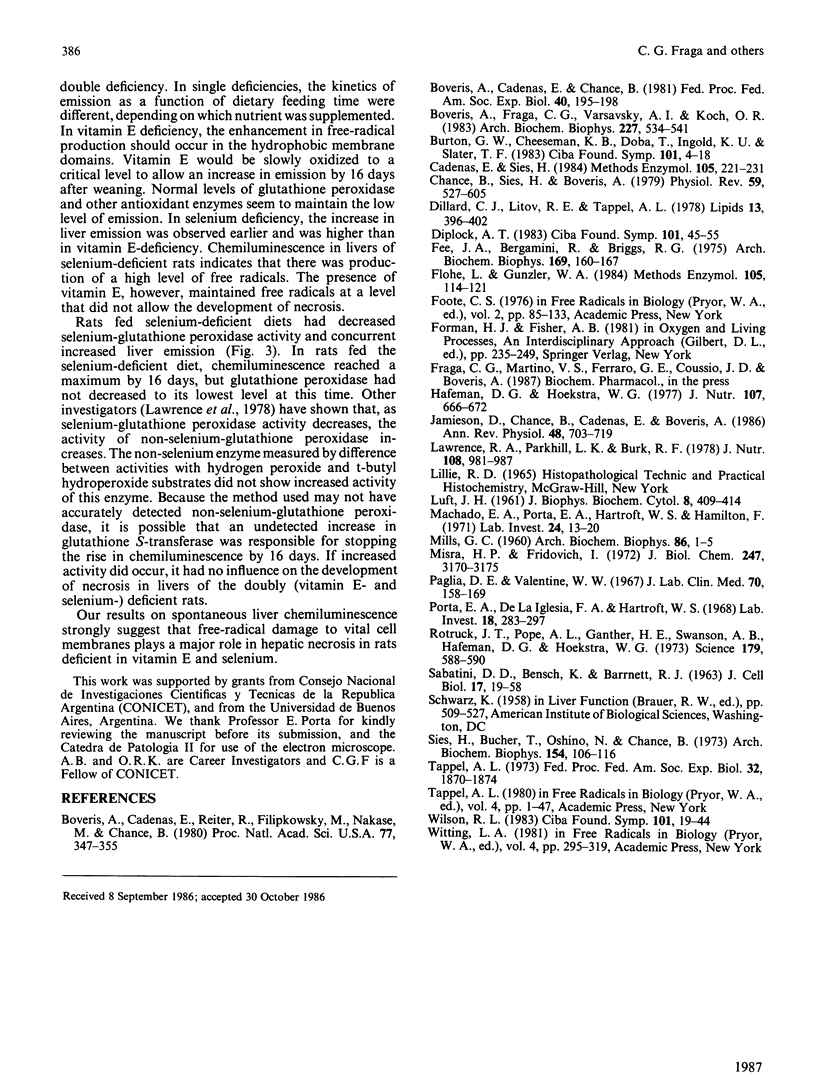Abstract
The role of vitamin E and selenium as protective agents against oxidative stress was evaluated by measuring liver chemiluminescence in situ. Weanling rats fed a vitamin E- and selenium-deficient diet showed liver chemiluminescence that was increased 60 and 100% over control values at 16 and 18 days respectively after weaning. At day 21, the double deficiency led to hepatic necrosis, as observed by optical and electron microscopy, and increased serum levels of lactate dehydrogenase and alanine aminotransferase. Single deficiencies, in either vitamin E or selenium, did not produce liver necrosis but increased liver chemiluminescence. Vitamin E deficiency led to a 23 and 50% increase in liver emission at days 18 and 20 respectively; selenium deficiency produced a 64% increase at day 16. The activity of liver selenium-glutathione peroxidase diminished to 13% of the control value in the rats fed doubly deficient and selenium-deficient diets. Activities of superoxide dismutase, catalase and non-selenium-glutathione peroxidase were not modified by the different diets. These results suggest that oxy-radical generation may play a major role in hepatic necrosis in vitamin E- and selenium-deficiency.
Full text
PDF



Selected References
These references are in PubMed. This may not be the complete list of references from this article.
- Boveris A., Cadenas E., Chance B. Ultraweak chemiluminescence: a sensitive assay for oxidative radical reactions. Fed Proc. 1981 Feb;40(2):195–198. [PubMed] [Google Scholar]
- Boveris A., Cadenas E., Reiter R., Filipkowski M., Nakase Y., Chance B. Organ chemiluminescence: noninvasive assay for oxidative radical reactions. Proc Natl Acad Sci U S A. 1980 Jan;77(1):347–351. doi: 10.1073/pnas.77.1.347. [DOI] [PMC free article] [PubMed] [Google Scholar]
- Boveris A., Fraga C. G., Varsavsky A. I., Koch O. R. Increased chemiluminescence and superoxide production in the liver of chronically ethanol-treated rats. Arch Biochem Biophys. 1983 Dec;227(2):534–541. doi: 10.1016/0003-9861(83)90482-4. [DOI] [PubMed] [Google Scholar]
- Burton G. W., Cheeseman K. H., Doba T., Ingold K. U., Slater T. F. Vitamin E as an antioxidant in vitro and in vivo. Ciba Found Symp. 1983;101:4–18. doi: 10.1002/9780470720820.ch2. [DOI] [PubMed] [Google Scholar]
- Cadenas E., Sies H. Low-level chemiluminescence as an indicator of singlet molecular oxygen in biological systems. Methods Enzymol. 1984;105:221–231. doi: 10.1016/s0076-6879(84)05029-1. [DOI] [PubMed] [Google Scholar]
- Chance B., Sies H., Boveris A. Hydroperoxide metabolism in mammalian organs. Physiol Rev. 1979 Jul;59(3):527–605. doi: 10.1152/physrev.1979.59.3.527. [DOI] [PubMed] [Google Scholar]
- Dillard C. J., Litov R. E., Tappel A. L. Effects of dietary vitamin E, selenium, and polyunsaturated fats on in vivo lipid peroxidation in the rat as measured by pentane production. Lipids. 1978 Jun;13(6):396–402. doi: 10.1007/BF02533708. [DOI] [PubMed] [Google Scholar]
- Diplock A. T. The role of vitamin E in biological membranes. Ciba Found Symp. 1983;101:45–55. doi: 10.1002/9780470720820.ch4. [DOI] [PubMed] [Google Scholar]
- Fee J. A., Bergamini R., Briggs R. G. Observations on the mechanism of the oxygen/dialuric acid-induced hemolysis of vitamin e-deficient rat red blood cells and the protective roles of catalase and superoxide dismutase. Arch Biochem Biophys. 1975 Jul;169(1):160–167. doi: 10.1016/0003-9861(75)90329-x. [DOI] [PubMed] [Google Scholar]
- Flohé L., Günzler W. A. Assays of glutathione peroxidase. Methods Enzymol. 1984;105:114–121. doi: 10.1016/s0076-6879(84)05015-1. [DOI] [PubMed] [Google Scholar]
- Hafeman D. G., Hoekstra W. G. Lipid peroxidation in vivo during vitamin E and selenium deficiency in the rat as monitored by ethane evolution. J Nutr. 1977 Apr;107(4):666–672. doi: 10.1093/jn/107.4.666. [DOI] [PubMed] [Google Scholar]
- Jamieson D., Chance B., Cadenas E., Boveris A. The relation of free radical production to hyperoxia. Annu Rev Physiol. 1986;48:703–719. doi: 10.1146/annurev.ph.48.030186.003415. [DOI] [PubMed] [Google Scholar]
- LUFT J. H. Improvements in epoxy resin embedding methods. J Biophys Biochem Cytol. 1961 Feb;9:409–414. doi: 10.1083/jcb.9.2.409. [DOI] [PMC free article] [PubMed] [Google Scholar]
- Lawrence R. A., Parkhill L. K., Burk R. F. Hepatic cytosolic non selenium-dependent glutathione peroxidase activity: its nature and the effect of selenium deficiency. J Nutr. 1978 Jun;108(6):981–987. doi: 10.1093/jn/108.6.981. [DOI] [PubMed] [Google Scholar]
- MILLS G. C. Glutathione peroxidase and the destruction of hydrogen peroxide in animal tissues. Arch Biochem Biophys. 1960 Jan;86:1–5. doi: 10.1016/0003-9861(60)90357-x. [DOI] [PubMed] [Google Scholar]
- Machado E. A., Porta E. A., Hartroft W. S., Hamilton F. Studies on dietary hepatic necrosis. II. Ultrastructural and enzymatic alterations of the hepatocytic plasma membrane. Lab Invest. 1971 Jan;24(1):13–20. [PubMed] [Google Scholar]
- Misra H. P., Fridovich I. The role of superoxide anion in the autoxidation of epinephrine and a simple assay for superoxide dismutase. J Biol Chem. 1972 May 25;247(10):3170–3175. [PubMed] [Google Scholar]
- Paglia D. E., Valentine W. N. Studies on the quantitative and qualitative characterization of erythrocyte glutathione peroxidase. J Lab Clin Med. 1967 Jul;70(1):158–169. [PubMed] [Google Scholar]
- Porta E. A., De la Iglesia F. A., Hartroft W. S. Studies on dietary epatic necrosis. Lab Invest. 1968 Mar;18(3):283–297. [PubMed] [Google Scholar]
- Rotruck J. T., Pope A. L., Ganther H. E., Swanson A. B., Hafeman D. G., Hoekstra W. G. Selenium: biochemical role as a component of glutathione peroxidase. Science. 1973 Feb 9;179(4073):588–590. doi: 10.1126/science.179.4073.588. [DOI] [PubMed] [Google Scholar]
- SABATINI D. D., BENSCH K., BARRNETT R. J. Cytochemistry and electron microscopy. The preservation of cellular ultrastructure and enzymatic activity by aldehyde fixation. J Cell Biol. 1963 Apr;17:19–58. doi: 10.1083/jcb.17.1.19. [DOI] [PMC free article] [PubMed] [Google Scholar]
- Sies H., Bücher T., Oshino N., Chance B. Heme occupancy of catalase in hemoglobin-free perfused rat liver and of isolated rat liver catalase. Arch Biochem Biophys. 1973 Jan;154(1):106–116. doi: 10.1016/0003-9861(73)90039-8. [DOI] [PubMed] [Google Scholar]
- Tappel A. L. Lipid peroxidation damage to cell components. Fed Proc. 1973 Aug;32(8):1870–1874. [PubMed] [Google Scholar]
- Willson R. L. Free radical protection: why vitamin E, not vitamin C, beta-carotene or glutathione? Ciba Found Symp. 1983;101:19–44. [PubMed] [Google Scholar]


